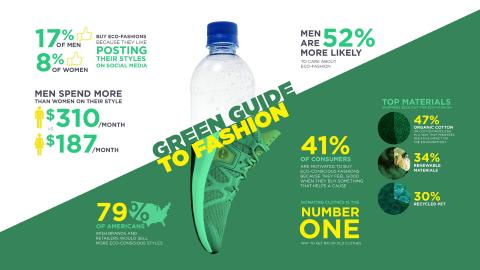In a world motivated by social cred and “likes,” it comes as no surprise that U.S. consumers on average spend roughly $250 a month on clothes, shoes and accessories. But what you might not expect is that men not only outspend women when it comes to their closet (spending an average of $310.50 per month on their wardrobe, compared to $187.20 for women), they are also 52 percent more likely than women to say they care a lot about eco-conscious fashion. Just in time for Earth Day, outdoor lifestyle brand Timberland shines a spotlight on what consumers value most when it comes to “going green” with their wardrobe.
This press release features multimedia. View the full release here: https://www.businesswire.com/news/home/20180418005829/en/

Timberland Wardrobe Values Survey Uncovers Consumer Eco-Fashion Behaviors (Graphic: Business Wire)
Timberland surveyed 1,000 men and women in the U.S. to understand the importance of the environmental impact of their style choices. The motivations behind men’s and women’s behaviors varied, but overall two-out-of-three (67%) consumers report they care at least a little about eco-conscious fashion, with more than half (55%) of consumers saying at least some of their current wardrobe is eco-conscious. A few highlights from the 2018 Timberland Wardrobe Values Survey include:
- A more responsible #OOTD: Two-in-five (41%) consumers say they are motivated to buy eco-conscious fashions because they feel good when they buy something that helps a cause, with another top motivator being knowing the product minimizes its negative impact on the environment (36%).
- Green humblebrag: For men, the motivation to buy eco-conscious fashions seems to be less altruistic and more self-interested. Roughly 30 percent buy eco-conscious clothes because they want other people to know they care about the environment (28% vs. 17% of women). In addition, for 17 percent of men, wearing eco-conscious fashions brings social cred, as they say they are motivated to buy eco-fashions because they like posting their styles on social media (vs. 8% for women).
- What’s in your wardrobe?: Despite the differences in their wardrobes, men and women tend to agree on the top materials they seek out when shopping for eco-fashion: organic cotton or cotton produced in a way that minimizes impact on the environment (47%); renewable materials (e.g., bamboo, hemp, wood pulp) (34%) and recycled PET (e.g., plastic bottles) (30%).
- Giving new life to old clothing: Donating clothes to charity is the No. 1 way to get rid of clothes, according to 70 percent of consumers, with 36 percent giving clothes away to friends or family and 28 percent choosing to recycle them. But women have the edge on men when it comes to disposing of clothes in an environmentally-responsible way, and are 14 percent more likely than men to donate old clothes (74% vs. 65%), whereas men are 82 percent more likely than women to throw their old clothes away (31% vs. 17%).
- Seeing green: Consumers say the top factor preventing them from buying eco-conscious fashions is that they seem more expensive than other products (38%), with not knowing “where to find them” close behind, at 33 percent. But the interest is clear: nearly four-in-five (79%) consumers wish brands and retailers would offer more eco-conscious styles.
“As Earthkeepers, we strive to make our products responsibly, in terms of the materials we use as well as how they are made,” said Alison Crowley, global brand manager for Timberland. “Whether it’s a beautifully crafted pair of boots or a new lightweight jacket, our customers won’t only look great this spring, they can also feel great knowing that every product we make is made with the environment in mind.”
This Earth Day, Timberland is making it easy to go green, with shoes and clothes so stylish you’d never know they were eco-conscious. Its spring 2018 collection includes a range of responsibly-made products, from oxfords with recycled rubber outsoles to canvas boots from the Timberland X Thread Collection, made with Thread™ Ground to Good™ fabric from plastic bottles collected in Haiti.
Key styles include:
- Men's 6” Premium Thread™ Canvas Boot: a classic boot with uppers made with Thread™ fabric from 50 percent recycled plastic bottles and linings made from 50 percent recycled plastic bottles
- Men’s FlyRoam™ Go Chukka: lightweight leather and fabric chukkas made with a breathable mesh lining from 100 percent recycled plastic bottles and durable outsoles made with 34 percent recycled rubber
- Men's Shelburne Twill Bomber Jacket: a modern length jacket with a lining that is 100 percent peached organic cotton
- Polarized Plastic Round Frame Sunglasses: round-framed sunglasses, made with at least 35 percent bio-based plastic
- Women’s FlyRoam™ Go Knit Oxford: lightweight oxford shoes made with a breathable mesh lining from 50 percent recycled plastic bottles and durable outsoles made with 34 percent recycled rubber
- Women’s Waterproof Trench Coat: a belted trench coat featuring a 100 percent recycled polyester lining
To learn more about Timberland’s commitments to create responsible products and to review the full findings of Timberland’s Wardrobe Values Survey, visit timberland.com/responsibility.
About Timberland
Timberland
is a global leader in the design, manufacturing and marketing of premium
footwear, apparel and accessories for the outdoor lifestyle. Best known
for its original yellow boot introduced in 1973, Timberland today
outfits consumers from toe-to-head, with versatile collections that
reflect the brand’s rich heritage of craftsmanship, function and style.
Timberland markets lifestyle products under the Timberland®
and Timberland Boot Company® brands, and industrial footwear
and workwear under the Timberland PRO® brand. Its products
are sold throughout the world in leading department and specialty stores
as well as company-owned retail locations and online. Timberland’s
dedication to making quality products is matched by an unwavering
commitment to environmental and social responsibility – to make things
better for its products, the outdoors, and communities around the globe.
To learn more about Timberland, a brand of VF Corporation (NYSE: VFC),
please visit timberland.com or follow us along the modern trail
@timberland.
View source version on businesswire.com: https://www.businesswire.com/news/home/20180418005829/en/
Contacts:
Katie Morrison, 617-939-8435
kmorrison@conecomm.com

